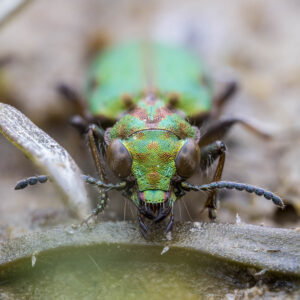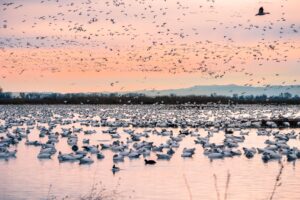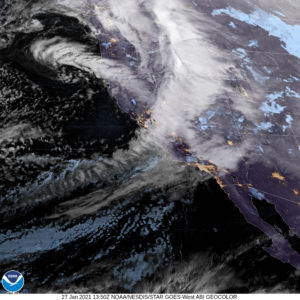The forecast calls for rain. Not too much. Mostly in the North Bay.
But finally.
Because maybe you have noticed something weird this year: It’s not raining. It has not rained much, it is not raining yet, and after this little impression this week the weather forecast calls once again for that wall of high pressure to build up and leave us eating Thanksgiving lunch under abundant sunshine.
While us people have fretted over those infernal blue skies and crazy November fog (like it’s July or something!), it’s probable that our local plants and animals have noticed much more acutely.
For amphibians, for example, the length of the annual long dry stretch is literally a matter of life and death: frogs retreat to underground moist areas during the hot summer months, says ecologist Michael Starkey, and emerge around the first rains of the season to breed. The longer the rains take to fall, the drier everything gets, the less refuge they can find and the greater a threat desiccation becomes. While Starkey says he didn’t know of any particular studies on the effect of this year’s drought on frogs, “I can tell you,” he said in an email, “that this lack of rain is likely going to cause problems for them. Basically, the longer the rain takes to fall, the harder it is for these animals to survive.”
It’s a double-whammy for frogs this year: a dry winter is often followed the next year by a wet fall, while wet winters allow ephemeral wetlands to stick around through even a dry fall. But a more rare dry winter followed by a dry fall — the phenomena that will almost certainly make 2013 the driest calendar year in recorded Bay Area history — means trouble. Because the dry period has stretched into the breeding season, Starkey said, this year could serve as a serious brake on amphibian population growth in a variety of Bay Area species.
Amphibians tend to hide out of sight, but you can go out and see the drought reflected in plant cover. The hills were brown by May, and it feels like it’s been fire season since January. At Coyote Hills Regional Park in Fremont, naturalist Kristina Parkison said even the sponge-like marshes have dried up in many places. Flood channels are now looking like upland habitat, with plants growing in them. “I really can’t remember when it was near the third week of November and we don’t have any water,” she said. “It dried up earlier this year than it normally does, and it dried out more thoroughly than it usually does.”
Shorebirds that flock to the ponds at Coyote Hills in the winter haven’t arrived in bulk yet, Parkison said. On a birdwalk last week she saw many familiar species — mallards, shovelers, green-winged teals, avocets and stilts — but not like she’d expect for late November in the marsh. While the nearby salt ponds, filled with water and unaffected by drought, seemed to support their usual numbers, the marshes around the park are pretty dry, she said. Looking out the window from the park visitor’s center, she spotted an egret. “So they’re not all gone,” she said, “but they’re probably like, ‘What the heck?’”
Up in the hills, California natives like manzanitas can cope, said manzanita expert Bert Johnson, but they’re not necessarily happy about it. Johnson said manzanitas on Mt. Diablo are showing serious signs of chlorosis and drought stress, but added in an email, “I have seen this happen before, and when the rains return, they perk up the following spring and summer with vibrant new growth.”
“Nature,” Johnson said, “is incredibly resilient, and manzanitas go through their good years, and their bad years.”
While drought stresses a lot of native plants, it can also provide an opportunity. For example, says Lech Naumovich of the Golden Hour Restoration Institute: it’s been a bad year for annual nonnative early germinators like Italian rye (Festuca perennis). But that means that perennial plants like native purple needlegrass (Nassella pulchra) seedlings will get a bit of time to stretch out and get comfy before the Italian rye returns. “This type of weather pattern certainly isn’t all bad from my perspective,” he said.
Several drought-adapted natives, actually, should be doing OK. While the rare vernal pools at Jepson Prairie Reserve in the Sacramento Valley weren’t much to look at this calendar year, everything out there’s pretty resilient about water, said Virginia Boucher at UC Davis’s John Muir Institute for the Environment. Native annual plants have seedbanks that are well-accustomed to waiting out a dry spell. Perennial plants have taproots down and will be poised to spring in the next rain. Tiger salamanders that breed in the pools live a surprising chunk of their lives in dry upland habitats.
Vernal pool poster-species fairy shrimps, well, they’ll just chill for 50 years if they need to.
“They’re ready for this,” Boucher said. “They could send them into outer space on the space capsule and they’d still be viable when they got back. These babies are tough.”
Tougher on many plants than the sustained dry period is the “early start” — last year’s strange pattern of heavy November and December rain followed by an extraordinarily dry January and February. Plants start their life cycles with the first rains, Naumovich said, then can’t finish when it dries up — meaning this year might be a bad year for annual plants even if the rains return.
The lack of grass seed can also have ripple effects up the food chain. Rusty Scalf, who co-teaches the Golden Gate Audubon Society’s Birds of the Bay Area class, said on a recent trip to Sibley Volcanic Regional Preserve he found the open areas were “almost desolate,” minus many of the sparrows and terrestrial birds that feed on grass seed. While that’s purely subjective — “not hard data, not a rigorous count,” he emphasized — he said he’s seen changes around the Bay Area, from dried-up vernal pools off Edgewater in Oakland to the dried-up marshes in Coyote Hills.
The dried-up plants also make life tough on a variety of pollinators. Honey bees, already under a variety of pressure from parasites and development, got slammed by the dry winter, says City Bees beekeeper Robert MacKimmie. Nationwide, MacKimmie says, there was a 40 percent bee die-off in 2012, much of it pegged to persistent drought across the Western United States, and he said he expects this year to be even worse. “Beekeepers have learned there is no normal anymore,” MacKimmie said, “so they’re expecting a certain amount of die off.”
Beekeepers in the Bay Area have been forced to rely on nutritional supplements for the bees: sugar water and soy-based protein feed. “At this point,” he said, “we’re nursing through a limited and modest amount of bees that will make it through the winter and flourish again in the spring, if it’s a normal year.”
Native bees face the same problems. But since so many urban gardeners haven’t yet turned off the tap, native pollinators are still finding their own lush private worlds, said UC Berkeley urban entomologist Gordon Frankie. Even out in the wildlands the bees should ride out the drought, Frankie said; in previous research projects he’s watched bee numbers dwindle in drought and then bounce back when the rains return.
“I’m not worried,” he said. “It’s well known some of these bees can hold over for several years without coming out. They can do that, conditions change and then the bees show up again.”
Allusions to a change in conditions, to a “normal” year, dominate a lot of weather conversations at the moment. The lesson, from plants to birds to bees, seems to be that a year or two of drought is OK, manageable, survivable: We’ll all make it through like the honeybees, with some sugar water and a protein lick, until the blessed rains come.
And that’s the point where everyone turns back to ask the weather forecaster, who for now can only return an indefinite shrug. As the water managers say, it only takes two or three big storms to change the whole outlook. Those storms can arrive any time now.





